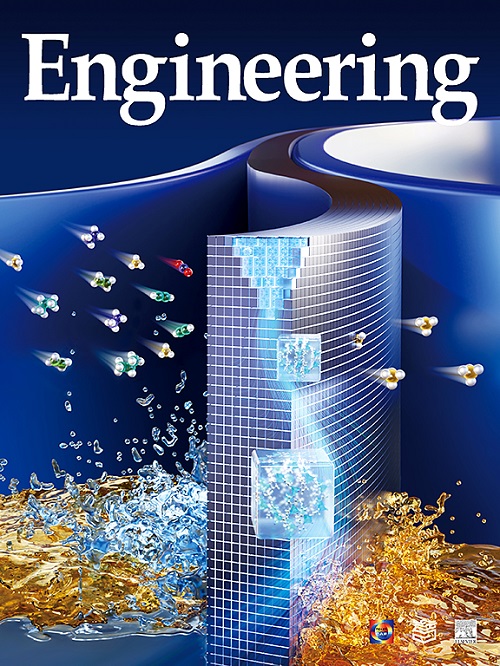电活性生物过滤动态膜对污水处理和污染缓解的影响:揭示污染层的生长平衡机制
IF 11.6
1区 工程技术
Q1 ENGINEERING, MULTIDISCIPLINARY
引用次数: 0
摘要
我们开发了一种涉及电活性生物过滤动态膜(EBDM)的废水处理和膜污染缓解策略。该方法利用厌氧动态膜生物反应器内的阴极电位来建立生长平衡的电活性污染层。在240天的运行周期中,EBDM表现出了出色的性能,其特点是超低的污染率(跨膜压力<;2.5 kPa),出水水质优越(化学需氧量(COD)去除>;浊度为93%,浊度为~ 2浊度单位(NTU)),甲烷(CH4)产量增加7.2%。形态学分析表明,EBDM作为一个生物过滤器,由一个结构化的、相互连接的、多层次的动态膜系统组成,并有有序的堵塞。在EBDM系统中,生长平衡的污染层呈现出较少的生物污染物和较松散的二级蛋白质结构。此外,外加电场改变了生物质的物理化学性质,导致污染电位降低。石英晶体微平衡耗散监测分析表明,与控制反应器中观察到的致密粘弹性污垢层相比,生长平衡促进了较松散的污垢层,吸附质量较低。宏基因组测序进一步表明,持续的电刺激促进了EBDM上具有增强微生物代谢功能的电活性污垢层的发展。这种方法选择性地改变了代谢途径,增加了污染物的降解。EBDM策略成功建立了一个有序堵塞、阶梯过滤和平衡生长的电活性污染层,在减少膜污染、提高出水质量和提高CH4生产率方面实现了协同效应。本文章由计算机程序翻译,如有差异,请以英文原文为准。

Development of Electroactive Biofiltration Dynamic Membrane for Enhanced Wastewater Treatment and Fouling Mitigation: Unraveling the Growth Equilibrium Mechanisms of Fouling Layer
We developed a strategy involving an electroactive biofiltration dynamic membrane (EBDM) for wastewater treatment and membrane fouling mitigation. This approach utilizes a cathode potential within an anaerobic dynamic membrane bioreactor to establish a growth equilibrium electroactive fouling layer. Over a 240 day operation period, the EBDM exhibited outstanding performance, characterized by an ultralow fouling rate (transmembrane pressure < 2.5 kPa), superior effluent quality (chemical oxygen demand (COD) removal > 93% and turbidity ∼2 nephelometric turbidity units (NTU)), and a 7.2% increase in methane (CH4) productivity. Morphological analysis revealed that the EBDM acted as a biofilter consisting of a structured, interconnected, multilevel dynamic membrane system with orderly clogging. In the EBDM system, the balanced-growth fouling layers presented fewer biofoulants and looser secondary protein structures. Furthermore, the applied electric field modified the physicochemical properties of the biomass, leading to a decrease in fouling potential. Quartz crystal microbalance with dissipation monitoring analysis indicated that growth equilibrium promoted a looser fouling layer with a lower adsorption mass than did the denser, viscoelastic fouling layer observed in the control reactor. Metagenomic sequencing further demonstrated that continuous electrical stimulation encouraged the development of an electroactive fouling layer with enhanced microbial metabolic functionality on the EBDM. This approach selectively modifies metabolic pathways and increases the degradation of foulants. The EBDM strategy successfully established an ordered-clogging, step-filtered, and balanced-growth electroactive fouling layer, achieving a synergistic effect in reducing membrane fouling, enhancing effluent quality, and improving CH4 productivity.
求助全文
通过发布文献求助,成功后即可免费获取论文全文。
去求助
来源期刊

Engineering
Environmental Science-Environmental Engineering
自引率
1.60%
发文量
335
审稿时长
35 days
期刊介绍:
Engineering, an international open-access journal initiated by the Chinese Academy of Engineering (CAE) in 2015, serves as a distinguished platform for disseminating cutting-edge advancements in engineering R&D, sharing major research outputs, and highlighting key achievements worldwide. The journal's objectives encompass reporting progress in engineering science, fostering discussions on hot topics, addressing areas of interest, challenges, and prospects in engineering development, while considering human and environmental well-being and ethics in engineering. It aims to inspire breakthroughs and innovations with profound economic and social significance, propelling them to advanced international standards and transforming them into a new productive force. Ultimately, this endeavor seeks to bring about positive changes globally, benefit humanity, and shape a new future.
 求助内容:
求助内容: 应助结果提醒方式:
应助结果提醒方式:


